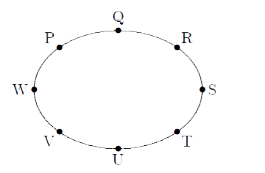Each of the four corners of a square with edge a is occupied by a point mass m. There is a fifth mass, also m, at the center of the square. To remove the mass from the center to a point far away the work that must be done by an external agent is given by:
4Gm2/a
−4Gm2/a
4√2Gm2/a
−4√2Gm2/a
The correct Answer is:C
To solve the problem of calculating the work done by an external agent to remove the mass from the center of a square to a point far away, we can follow these steps:
Step 1: Understand the Configuration
We have a square with side length a and point masses m at each of the four corners (let's label them A, B, C, and D) and one mass m at the center (O) of the square.
Step 2: Calculate the Distance from the Center to the Corners
The distance from the center (O) to any corner (e.g., A) can be calculated using the Pythagorean theorem. The diagonal of the square is given by:
d=√a2+a2=a√2
Since O is the midpoint of the diagonal, the distance from O to A (or any corner) is:
r=a√22=a√2
Step 3: Calculate the Initial Potential Energy
The gravitational potential energy U between two masses m1 and m2 separated by a distance r is given by:
U=−Gm1m2r
In our case, the mass at the center (O) interacts with each of the four corner masses (A, B, C, D). The initial potential energy Uinitial when the mass is at the center is:
Uinitial=UOA+UOB+UOC+UOD
Since all distances are equal, we can express this as:
Uinitial=4⎛⎜⎝−Gm2a√2⎞⎟⎠=−4Gm2√2a
Step 4: Calculate the Final Potential Energy
When the mass is moved to a point far away (at infinity), the gravitational potential energy approaches zero:
Ufinal=0
Step 5: Calculate the Work Done
The work done by the external agent is equal to the change in potential energy:
W=Ufinal−Uinitial=0−(−4Gm2√2a)=4Gm2√2a
Final Answer
Thus, the work done by the external agent to remove the mass from the center to a point far away is:
W=4Gm2√2a
We have a square with side length a and point masses m at each of the four corners (let's label them A, B, C, and D) and one mass m at the center (O) of the square.
The distance from the center (O) to any corner (e.g., A) can be calculated using the Pythagorean theorem. The diagonal of the square is given by:
d=√a2+a2=a√2
Since O is the midpoint of the diagonal, the distance from O to A (or any corner) is:
r=a√22=a√2
The gravitational potential energy U between two masses m1 and m2 separated by a distance r is given by:
U=−Gm1m2r
In our case, the mass at the center (O) interacts with each of the four corner masses (A, B, C, D). The initial potential energy Uinitial when the mass is at the center is:
Uinitial=UOA+UOB+UOC+UOD
Since all distances are equal, we can express this as:
Uinitial=4⎛⎜⎝−Gm2a√2⎞⎟⎠=−4Gm2√2a
When the mass is moved to a point far away (at infinity), the gravitational potential energy approaches zero:
Ufinal=0
The work done by the external agent is equal to the change in potential energy:
W=Ufinal−Uinitial=0−(−4Gm2√2a)=4Gm2√2a
Thus, the work done by the external agent to remove the mass from the center to a point far away is:
W=4Gm2√2a
Topper's Solved these Questions
- BOOK - VMC MODULES ENGLISHCHAPTER - GRAVITATIONEXERCISE - Level-230videos
GRAVITATION
- BOOK - VMC MODULES ENGLISHCHAPTER - GRAVITATIONEXERCISE - JEE Main (Archive)43videos
GRAVITATION
- BOOK - VMC MODULES ENGLISHCHAPTER - GRAVITATIONEXERCISE - LEVEL -0 Long Answer Type3videos
GRAVITATION
- BOOK - VMC MODULES ENGLISHCHAPTER - GASEOUS STATE & THERMODYNAMICSEXERCISE - JEE ADVANCED (ARCHIVE )111videos
GASEOUS STATE & THERMODYNAMICS
- BOOK - VMC MODULES ENGLISHCHAPTER - INTRODUCTION TO VECTORS & FORCES EXERCISE - JEE Advanced ( ARCHIVE LEVEL-2)12videos
INTRODUCTION TO VECTORS & FORCES
Similar Questions
Knowledge Check
- Question 1 - Select One
Four particles each of mass m are placed at the vertices of a square of side l. the potential at the centre of square is
A−√2Gm2l(2−1√2)B−2Gm2l(2+1√2)C−√2Gm2l(√2−1√2)D−2Gm2l(√2−1√2)
Two particles, each of mass m, are a distance d apart. To bring a third particle, also having mass m, from far away to the point midway between the two particles an external agent does work given by:
View SolutionFour point masses each mass m kept at the vertices of a square. A point mass m is kept at the point of intersection of the diagonal of a square. What be the force experienced by central mass m ?
View SolutionA planet travels in an elliptical orbit about a star as shown. At what pair of points is the speed of the planet the same?
 View Solution
View SolutionFour equal positive charges, each of value Q, are arranged at the four corners of a square of diagonal 2a. A small body of mass m carrying a unit positive charge is placed at height h above the center of the square.
What should be the value of Q in order that this body may be in equilibrium?View SolutionFour particles each of mass 'm' are kept at the four corners of a square of edge 'a'. Find the moment of inertia of the system about a line perpendicular to the plane of the square and passing through the center of the square.
View SolutionFour equal masses (each of mass M) are placed at the corners of a square of side a. The escape velocity of a body from the centre O of the square is
View SolutionThree masses, each equal to M, are placed at the three corners of a square of side a. the force of attraction on unit mass at the fourth corner will be
View Solution

